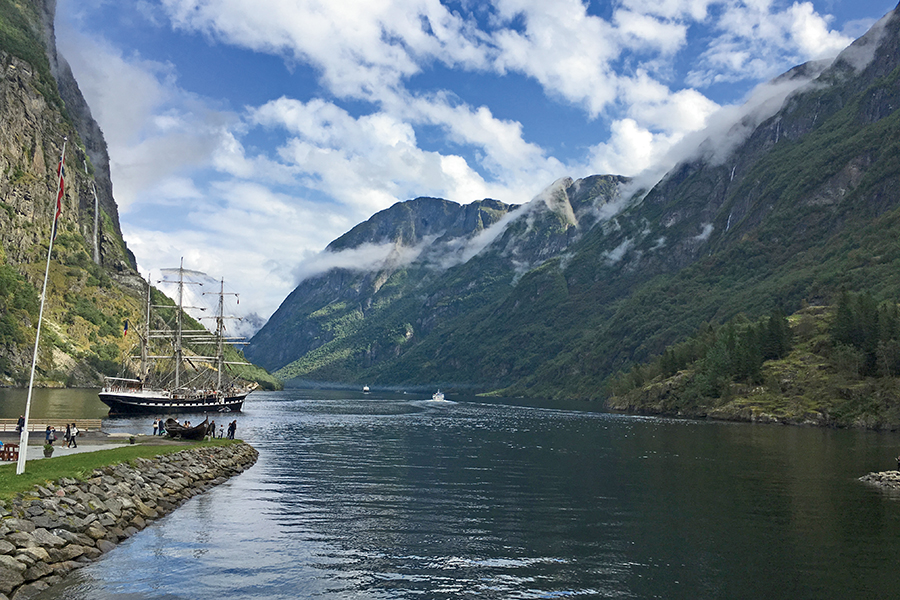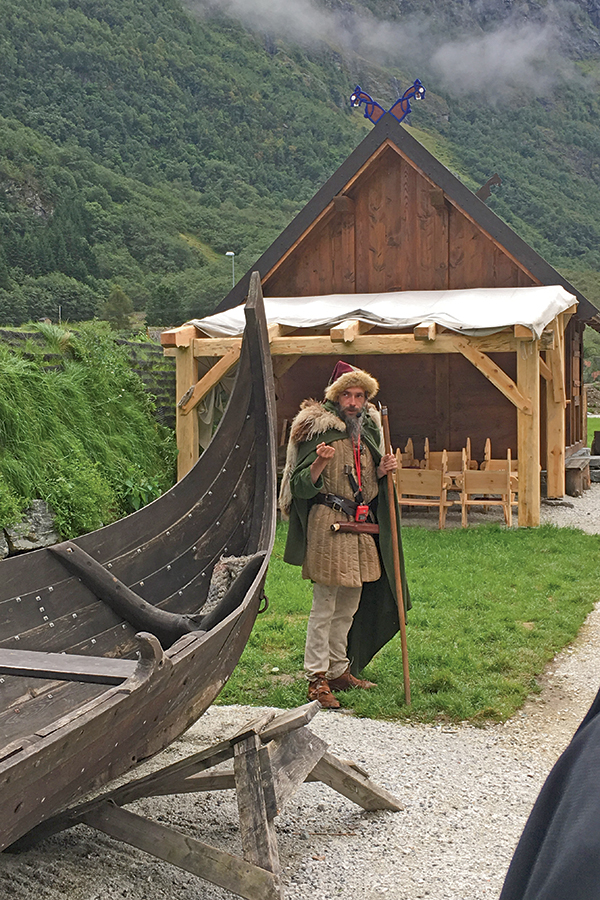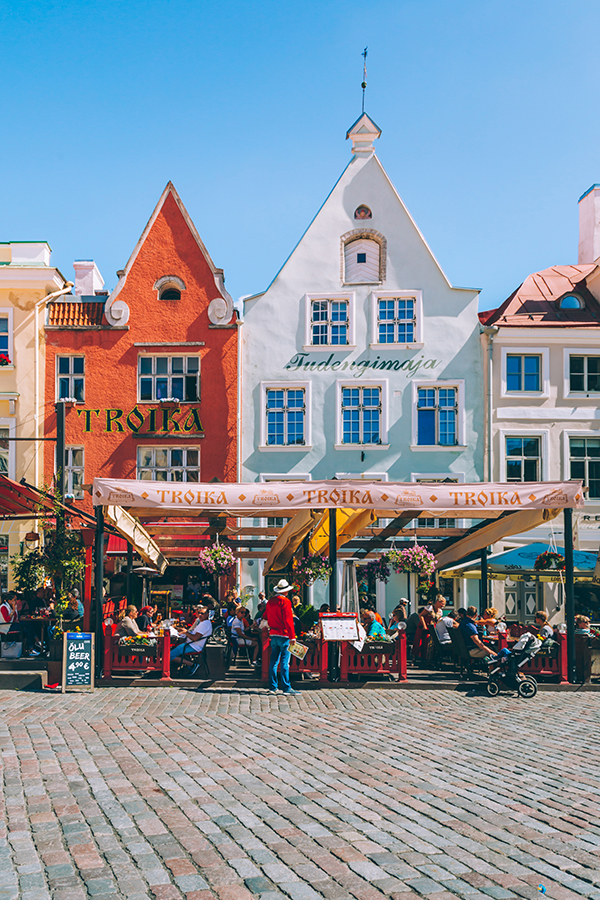Viking Homelands: Unexpected discoveries

The Viking Valley, in the heart of the unique UNESCO-listed Norwegian fjord landscape in Gudvangen, Norway, brings to life the real history and culture of the Viking age. © AAA Colorado/Kevin Hobbs
Vikings! The very word was enough to strike terror from northern Europe to the Middle East. The bloodthirsty brutes stormed ashore from swift longboats, pillaging for profit and pleasure, using the skulls of the vanquished for drinking goblets as their horned helmets gleamed in the firelight of burning villages.
At least, that’s the story I’d always heard. Now, I was on a voyage that would challenge my long-held notions and reveal unexpected discoveries across the heart of the Viking homelands.
Demolishing stereotypes

Fittingly, my journey was aboard a Viking Ocean Cruises ship traveling between Stockholm, Sweden; St. Petersburg, Russia; and Bergen, Norway. These waters were very familiar to the Norse seafarers whose skill as shipbuilders and navigators launched explorations that led to what I’ve determined was more than a thousand years of bad press.
I wasn’t thinking as much about the Vikings as I was about the Romanovs as I walked the grounds of the Hermitage Museum in St. Petersburg. The massive complex, which includes the stunningly beautiful Winter Palace, was far more opulent than I had imagined. I could understand why thousands of impoverished Russians came here in 1905 to petition the Tsar for better pay and working conditions. They were mowed down by imperial troops in what became known as the Bloody Sunday Massacre, an event that set the stage for the revolution that ended the reign of the Tsars, and, ultimately, the lives of the ruling Romanov family. Amid the magnificence of Palace Square, I paused at a plaque that marked the grim history behind the gilded splendor.
As our ship left the pier in St. Petersburg, I downed a traditional shot of Russian vodka and reflected on the depth of Russia’s ties to the Vikings, and how the country’s name may derive from Scandinavian merchant-warriors. Already on this voyage, I’d learned Viking explorations were based more on trading than raiding, and their savage reputation may spring from the infamy of just one particularly ferocious attack on an island abbey off the coast of England in 793. There’s not even any evidence that Vikings wore the horned helmets so identified with them. As our cruise ship followed the same route plied long ago by Viking longboats, other stereotypes were about to be demolished.
History explained
 Experience the shops and restaurants in the medieval Old Town of Tallinn, Estonia. Courtesy of Viking
Experience the shops and restaurants in the medieval Old Town of Tallinn, Estonia. Courtesy of Viking
I love the grand sweep of history, and the Vikings certainly embody much of the history of northern Europe, especially the Baltic Sea that I was exploring on this AAA Colorado President’s Cruise to the Viking homelands. As I discovered in our cruise’s ports of call, this region’s more recent history is compelling and, even for a history buff like me, subject to misinterpretation. For many years, I regarded the Baltic nations of Estonia, Lithuania, and Latvia as indistinguishable extensions of the former Soviet Union, primarily Russian in character. There may be no more enjoyable place to face such an error than a beer garden in Tallinn, Estonia. Tallinn’s walled Old City is one of Europe’s most complete and well preserved. Its architecture blends medieval and modern, and the atmosphere is vibrant. Still, its people may be its most exciting feature. Just now coming into their own after decades of domination by larger powers including Denmark, Germany, Poland, and Soviet Russia, Estonians are eager to show off their own distinct culture to visitors. At my beer garden visit, the beer wasn’t the only thing flowing. Estonian servers flooded me with advice on where to go and what to see, expressing extreme pride in their young and independent nation, and making it clear that they’re not Russians, Germans, Poles, Danes, or anyone other than Estonians.
Celebrating the Vikings
In Poland, archaeologists have found traces of Viking settlements, and every year there’s a large Viking festival held on an island in the Baltic, reenacting the historical coexistence, peaceful and otherwise, of Vikings and Slavs. You’ll see recreated villages and longboats, but no horned helmets. Our port of call in Poland was Gdansk, where there are statues to a national hero who is still alive. As a Gdansk shipyard worker, Lech Walesa led the Solidarity movement that challenged authoritarian leaders under Soviet sway. In 1990, Walesa became Poland’s first freely elected head of state in more than 60 years. The historical importance of Gdansk as a flashpoint for World War II (Germany claimed the city and called it Danzig) and its role in ending Soviet domination of Eastern Europe fit well with its elegant architecture, making Gdansk a satisfying discovery along the route of the Vikings.
 Denmark’s Princess Josephine and Prince Vincent steal the show from their parents, Crown Prince Federik and Princess Mary, on their first day of school. © AAA Colorado/Barbara Hobbs
Denmark’s Princess Josephine and Prince Vincent steal the show from their parents, Crown Prince Federik and Princess Mary, on their first day of school. © AAA Colorado/Barbara Hobbs
Cruising into the home waters of the Vikings, the scenic beauty that I expected to see revealed itself, but ashore there were more surprises. In Copenhagen, my wife and I stumbled onto a frenzy in front of a royal palace. The 7-year-old twins of one of Denmark’s princesses were getting into a car that would take them to their first day of school. It was a plethora of paparazzi! But then, the twins are fourth and fifth in line to the Danish throne and as descendants of Queen Victoria, they’re also in line for the British throne. Oh no, more Vikings with their eyes on England.
New perspectives
 The Norwegian fjords from the bow of a Viking ocean ship near Eidfjord, Norway. Courtesy of Viking
The Norwegian fjords from the bow of a Viking ocean ship near Eidfjord, Norway. Courtesy of Viking
Entering the fjords of Norway around Stavanger and Bergen, it’s impossible not to appreciate the accomplishments of the Vikings who sailed out of these inlets and into legend. Before this cruise, I knew the Vikings were incredibly accomplished explorers. I thought I knew that they were fearsome barbarians in horned helmets who preyed on more “civilized” cultures.
I’ve been on many cruises to many places; the Caribbean, Alaska, the Mexican Riviera. I’ve enjoyed them all, but to some extent, those experiences were all in line with my expectations. This cruise was different. It seized my preconceived notions and stereotypes and tossed them overboard, reminding me that travel can force you to re-think things you thought you knew.
In some ways, my journey was like so many taken by the Vikings themselves, out of a safe harbor and into the unknown, arriving at a new perspective.
Kevin Hobbs is the vice president of marketing and communications for AAA Colorado. He has been in the travel industry for more than 40 years and has been on dozens of cruises.